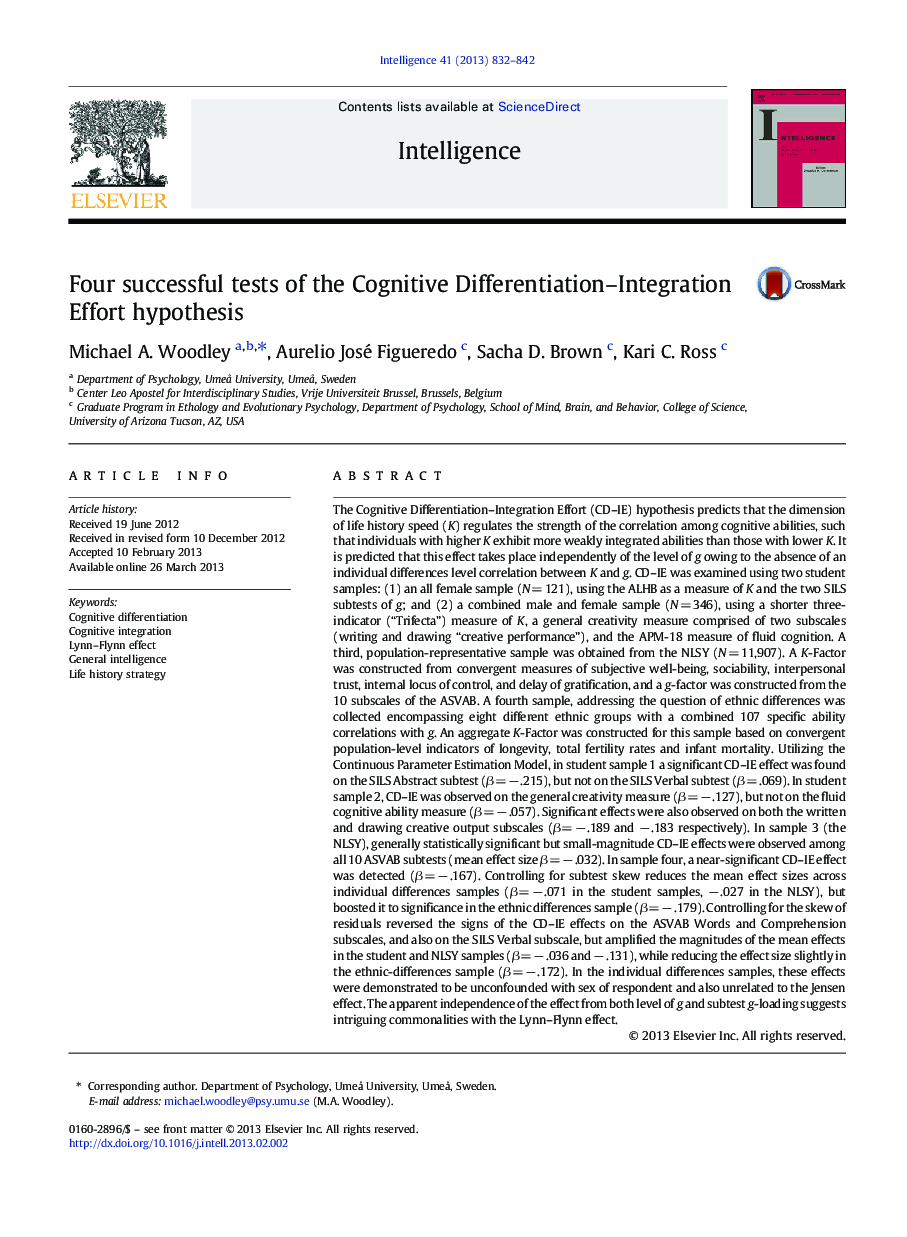| کد مقاله | کد نشریه | سال انتشار | مقاله انگلیسی | نسخه تمام متن |
|---|---|---|---|---|
| 929164 | 922543 | 2013 | 11 صفحه PDF | دانلود رایگان |

The Cognitive Differentiation–Integration Effort (CD–IE) hypothesis predicts that the dimension of life history speed (K) regulates the strength of the correlation among cognitive abilities, such that individuals with higher K exhibit more weakly integrated abilities than those with lower K. It is predicted that this effect takes place independently of the level of g owing to the absence of an individual differences level correlation between K and g. CD–IE was examined using two student samples: (1) an all female sample (N = 121), using the ALHB as a measure of K and the two SILS subtests of g; and (2) a combined male and female sample (N = 346), using a shorter three-indicator (“Trifecta”) measure of K, a general creativity measure comprised of two subscales (writing and drawing “creative performance”), and the APM-18 measure of fluid cognition. A third, population-representative sample was obtained from the NLSY (N = 11,907). A K-Factor was constructed from convergent measures of subjective well-being, sociability, interpersonal trust, internal locus of control, and delay of gratification, and a g-factor was constructed from the 10 subscales of the ASVAB. A fourth sample, addressing the question of ethnic differences was collected encompassing eight different ethnic groups with a combined 107 specific ability correlations with g. An aggregate K-Factor was constructed for this sample based on convergent population-level indicators of longevity, total fertility rates and infant mortality. Utilizing the Continuous Parameter Estimation Model, in student sample 1 a significant CD–IE effect was found on the SILS Abstract subtest (β = − .215), but not on the SILS Verbal subtest (β = .069). In student sample 2, CD–IE was observed on the general creativity measure (β = − .127), but not on the fluid cognitive ability measure (β = − .057). Significant effects were also observed on both the written and drawing creative output subscales (β = − .189 and − .183 respectively). In sample 3 (the NLSY), generally statistically significant but small-magnitude CD–IE effects were observed among all 10 ASVAB subtests (mean effect size β = − .032). In sample four, a near-significant CD–IE effect was detected (β = − .167). Controlling for subtest skew reduces the mean effect sizes across individual differences samples (β = − .071 in the student samples, − .027 in the NLSY), but boosted it to significance in the ethnic differences sample (β = − .179). Controlling for the skew of residuals reversed the signs of the CD–IE effects on the ASVAB Words and Comprehension subscales, and also on the SILS Verbal subscale, but amplified the magnitudes of the mean effects in the student and NLSY samples (β = − .036 and − .131), while reducing the effect size slightly in the ethnic-differences sample (β = − .172). In the individual differences samples, these effects were demonstrated to be unconfounded with sex of respondent and also unrelated to the Jensen effect. The apparent independence of the effect from both level of g and subtest g-loading suggests intriguing commonalities with the Lynn–Flynn effect.
► CD–IE predicts ability differentiation by life history speed (level of K).
► CD–IE, unlike SLODR should be independent of level of g.
► CPEM is used in investigating four datasets for the effect.
► The effect is detected in student, population and ethnic differences data.
► CD–IE shares substantive phenomenology with the Lynn–Flynn effect.
Journal: Intelligence - Volume 41, Issue 6, November–December 2013, Pages 832–842